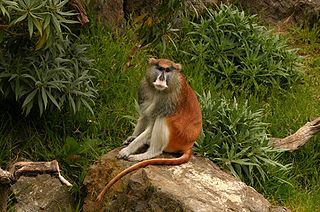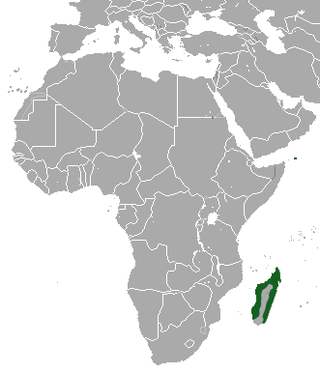
Erythrocebus is a genus of Old World monkey. All three species in this genus are found in Africa, and are known as patas monkeys. While previously considered a monotypic genus containing just E. patas, a 2017 review argued that, based on morphological evidence and heavy geographic separation between taxa, E. patas should be split back into distinct species as recognised in the 19th century.

The Puerto Rican nesophontes, or Puerto Rican shrew, is an extinct eulipotyphlan endemic to Puerto Rico.

Nesophontes, sometimes called West Indies shrews, is the sole genus of the extinct, monotypic mammal family Nesophontidae in the order Eulipotyphla. These animals were small insectivores, about 5 to 15 cm long, with a long slender snout and head and a long tail. They were endemic to the Greater Antilles, in Cuba, Hispaniola, Puerto Rico, the United States Virgin Islands, and the Cayman Islands.
Neacomys musseri, also known as Musser's neacomys or Musser's bristly mouse, is a rodent species from South America. It is found in far western Brazil and southeastern Peru.
The Atalaye nesophontes is an extinct species of mammal in the family Nesophontidae. It was endemic to Hispaniola in the Caribbean, and is only known from fossil deposits.

The western Cuban nesophontes is an extinct species of mammal in the family Nesophontidae. It was found on Cuba and Hispaniola. It was recently discovered to include three previously thought species: N. submicrus, N. longirostris, and N. superstes.
The St. Michel nesophontes is an extinct species of mammal in the family Nesophontidae. It was endemic to Hispaniola.

The Ruwenzori shrew is a species of mammal in the family Soricidae. It is the only species within the genus Ruwenzorisorex. It is found in Burundi, Democratic Republic of the Congo, Rwanda, and Uganda. It is semiaquatic, living along streams in tropical cloud forest.
Marcano's solenodon is an extinct species of mammal in the family Solenodontidae known only from skeletal remains found on the island of Hispaniola.

The Madagascan pygmy shrew is a species of mammal in the family Soricidae. It is the only known Malagasy shrew.
The Caribbean bioregion is a biogeographic region that includes the islands of the Caribbean Sea and nearby Atlantic islands, which share a fauna, flora and mycobiota distinct from surrounding bioregions.

The greater Cuban nesophontes is an extinct species of eulipotyphlan that was native to Cuba. It is thought that the introduction of rats lead to its demise.

The Colombian small-eared shrew is a species of mammal in the family Soricidae. It is endemic to Colombia, where it is known from the Cordillera Central in Antioquia Department at elevations from 1,750 to 2,800 m. It is found in montane forest and cultivated areas. It resembles C. brachyonyx.
The Cayman nesophontes is an extinct eulipotyphlan of the genus Nesophontes that was once endemic to the Cayman Islands ; the animal lived in the island montane forest/brush endemic to the Cayman Islands and was an insectivore. It is known from subfossil remains, that bear bite marks attributed to crocodiles, collected from caves, sinkholes and peat deposits on the Islands between the 1930s and the 1990s. It was named in 2019.







